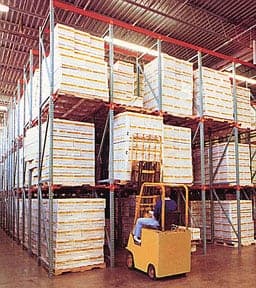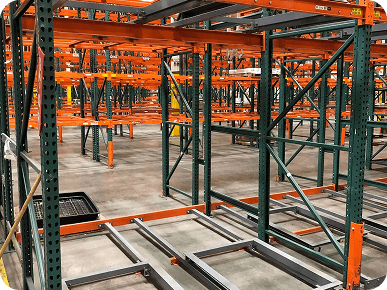Making informed decisions about warehouse storage systems requires understanding the critical factors that impact safety, efficiency, and return on investment. Among these factors, pallet rack capacity stands as perhaps the most fundamental consideration. This guide breaks down complex load capacity information into practical knowledge you can apply when selecting, upgrading, or optimizing your warehouse racking systems.
Why Capacity Matters in Your Warehouse Operation
Load capacity directly impacts three critical aspects of your operation: safety compliance, infrastructure investment, and operational flexibility. Proper capacity selection prevents costly rack failures, avoids safety incidents, and accommodates your evolving storage requirements.
Many facility managers find themselves overwhelmed by technical specifications, engineering tables, and industry jargon when evaluating racking options. This guide translates those complexities into straightforward principles you can apply to your specific warehouse environment.
Frame Capacity Fundamentals: What You Need to Know
Frame capacity represents the maximum weight a rack upright can safely support under normal operating conditions. This includes both your stored product weight and the rack components themselves (typically calculated as an additional 2% of product weight).
Three primary factors determine frame capacity:
- Post Gauge and Profile – Thicker steel (lower gauge numbers) and wider profiles provide higher load capacities
- Frame Depth – Deeper frames offer greater stability and higher weight capacity
- Unsupported Height – The vertical distance between beam levels (or from floor to first beam) dramatically affects overall capacity
The relationship between these factors follows consistent patterns: capacity decreases as unsupported height increases, and narrower frames support less weight than deeper ones at equivalent heights.
Practical Capacity Selection: A Decision Framework
When evaluating your storage requirements, match your operation’s needs to capacity ranges using this practical framework:
Light Duty Applications (Under 25,000 lbs)
- Best Options: Bolted 314 frames (14 GA) or Welded 70F frames
- Ideal For: Retail distribution, light manufacturing, general warehousing
- Key Consideration: Most economical option for standard pallet loads while maintaining safety margins
Medium Duty Applications (25,000-40,000 lbs)
- Best Options: Bolted 312 frames (12 GA) or Welded 77F frames
- Ideal For: Distribution centers, mixed SKU warehousing, manufacturing supply
- Key Consideration: Optimal balance of investment and capacity for most warehouse operations
Heavy Duty Applications (40,000-60,000 lbs)
- Best Options: Bolted 102/122 frames or Welded 99F frames
- Ideal For: Heavy manufacturing, beverage distribution, building materials storage
- Key Consideration: Superior strength with enhanced durability in high-traffic environments
Extreme Duty Applications (Over 60,000 lbs)
- Best Options: UA10 frames or custom reinforced solutions
- Ideal For: Automotive parts, metal storage, machinery components, dense product storage
- Key Consideration: Maximum capacity with built-in damage resistance for the most demanding applications
Translating Your Requirements to Frame Selection
Use this three-step process to identify the right capacity for your operation:
Step 1: Calculate Total Requirements
- Pallet weight × pallets per level = required beam capacity
- Number of beam levels × weight per level = required frame capacity
- Maximum spacing between beams = unsupported height
Step 2: Reference Capacity Tables
- Locate the frame model that exceeds your calculated capacity requirements
- Find the column matching your unsupported height
- The intersection shows available capacity
- Add 15-20% buffer for operational variability and future growth
Step 3: Consider Operational Factors
- Uneven loading patterns may require higher rated capacity
- High-turnover areas benefit from added protection and strength
- Seismic zones require special considerations and possibly reinforced options
- Future growth plans may justify higher capacity investment now
Capacity Table Simplified Reference
For quick reference during planning, use this simplified table showing capacity ranges (in thousands of pounds) at common beam spacings:
| Frame Type | 48″ Spacing | 72″ Spacing | 96″ Spacing | 120″ Spacing |
|---|---|---|---|---|
| Bolted 314 (Light) | 21-25k | 13-16k | 7-10k | 5-6k |
| Bolted 312 (Medium) | 30-34k | 18-21k | 10-14k | 7-8k |
| Bolted 102 (Heavy) | 36-43k | 27-33k | 18-21k | 11-14k |
| Bolted 122 (Heavy+) | 51-55k | 42-45k | 31-37k | 22-26k |
| UA10 (Extreme) | 78-86k | 57-65k | 37-42k | 24-29k |
| Welded 70F (Light) | 24-28k | 15-18k | 9-12k | 6-7k |
| Welded 77F (Medium) | 33-38k | 21-24k | 12-16k | 8-10k |
| Welded 99F (Heavy) | 53-58k | 41-47k | 29-35k | 19-23k |
Addressing Common Capacity Considerations
“How do I determine the true weight capacity needs for my operation?”
Look beyond current average weights. Calculate based on your heaviest pallets, not just averages. For example, if most pallets weigh 1,800 pounds but occasionally reach 2,400 pounds, design for the higher weight. Then multiply by your beam levels and add a safety factor: “If your heaviest pallets are 2,400 pounds with 3 pallets per level and 4 levels high, each bay needs to support at least 28,800 pounds (2,400 × 3 × 4).”
“What’s the relationship between capacity and long-term cost of ownership?”
Frame this as an operational decision: “While lower capacity systems may reduce initial investment, they often lead to higher lifetime costs through damage repair, limited flexibility, and potential replacement. Higher capacity systems typically offer longer lifespan, better damage resistance, and adaptability to changing inventory needs—reducing your total cost of ownership.”
“Can I increase capacity in my existing racking if our needs change?”
Present practical options: “Yes, capacity can be increased through several methods. Frame reinforcement can boost capacity by up to 85% in specific sections. Alternatively, reducing unsupported height by adding intermediate beam levels increases capacity. However, it’s typically more cost-effective to select appropriate capacity during initial installation rather than retrofit later.”
“Why do capacity ratings vary between manufacturers?”
Explain industry standards and testing: “Capacity ratings should comply with RMI and ANSI standards, but testing methodologies may differ. Some ratings reflect ideal laboratory conditions, while others incorporate real-world factors like uneven loading and dynamic stresses. When comparing, look for ratings that specify testing conditions and include appropriate safety factors for warehouse environments.”
Optimizing Capacity for Operational Excellence
ROI Considerations for Capacity Selection
Frame your capacity decisions within an ROI context:
- Higher initial capacity extends racking lifespan, preventing costly mid-cycle replacements
- Proper capacity selection eliminates productivity losses from rack failures or capacity limitations
- Enhanced protection features reduce maintenance costs from operational impacts
- Appropriate capacity enables inventory flexibility as business needs evolve
Capacity Verification Best Practices
Implement these processes to ensure your racking maintains specified capacities:
- Professional installation to ensure optimal load distribution
- Post-installation inspection to verify compliance with capacity specifications
- Regular documentation for insurance requirements and safety audits
- Periodic inspections to identify potential issues before they affect capacity
Implementing Capacity Knowledge in Your Operation
Apply your capacity expertise when facing these common scenarios:
- Warehouse expansion or reconfiguration projects
- Changing product mix with varying weights
- Increasing inventory density requirements
- Addressing safety concerns or compliance issues
- Planning for operational growth and flexibility
By understanding the relationship between frame components, dimensions, and capacity, you make informed decisions that balance safety, cost, and operational flexibility. This knowledge helps you avoid the common pitfalls of under-specification (safety risks) and over-specification (unnecessary expense).
Remember: effective warehouse management isn’t just about maximizing storage density—it’s about creating a safe, efficient system that protects your inventory investment and supports your operational goals for years to come.



